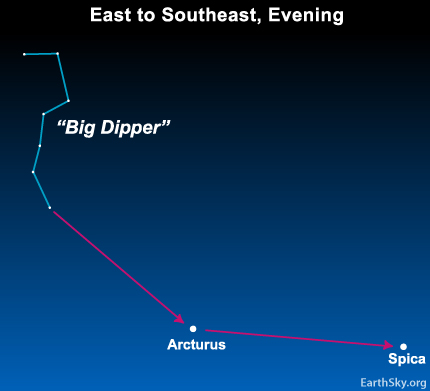
One of my favorite constellations, little squarish Corvus the Crow, can be found in the south after sunset at this time of year. It’s not far from the bright star Spica – brightest light in the constellation Virgo the Maiden. Learn more about how to find Spica.
Once you find Spica in spring of any year, you’ll recognize the constellation Corvus. It’s always near the star Spica on the sky’s dome. It’s recognizable for its compact, boxy shape. But this year, in 2017, we have the dazzling planet Jupiter to guide us to the star Spica and the constellation Corvus.
Corvus is an easy constellation to pick out in the sky. In Greek mythology, Corvus was seen as the cupbearer to Apollo, god of the sun. In ancient Israel, Corvus wasn’t a crow. Instead, it was seen as a raven. In China, this grouping of stars had more distinction as an Imperial Chariot, riding on the wind.
Corvus is a friendly sight in the heavens. Along with all the stars, Corvus’s stars will be found a bit farther west at nightfall in the coming weeks and months as Earth moves around the sun. Check it out now and watch for it in the next few months. The bright star Spica – near Corvus on our sky’s dome – will always be there to guide your eye.
Bottom line: Use the star Spica to introduce yourself to the constellation Corvus the Crow.
Enjoying EarthSky so far? Sign up for our free daily newsletter today!
from EarthSky https://ift.tt/1gyVT9Z

One of my favorite constellations, little squarish Corvus the Crow, can be found in the south after sunset at this time of year. It’s not far from the bright star Spica – brightest light in the constellation Virgo the Maiden. Learn more about how to find Spica.
Once you find Spica in spring of any year, you’ll recognize the constellation Corvus. It’s always near the star Spica on the sky’s dome. It’s recognizable for its compact, boxy shape. But this year, in 2017, we have the dazzling planet Jupiter to guide us to the star Spica and the constellation Corvus.
Corvus is an easy constellation to pick out in the sky. In Greek mythology, Corvus was seen as the cupbearer to Apollo, god of the sun. In ancient Israel, Corvus wasn’t a crow. Instead, it was seen as a raven. In China, this grouping of stars had more distinction as an Imperial Chariot, riding on the wind.
Corvus is a friendly sight in the heavens. Along with all the stars, Corvus’s stars will be found a bit farther west at nightfall in the coming weeks and months as Earth moves around the sun. Check it out now and watch for it in the next few months. The bright star Spica – near Corvus on our sky’s dome – will always be there to guide your eye.
Bottom line: Use the star Spica to introduce yourself to the constellation Corvus the Crow.
Enjoying EarthSky so far? Sign up for our free daily newsletter today!
from EarthSky https://ift.tt/1gyVT9Z


Aucun commentaire:
Enregistrer un commentaire